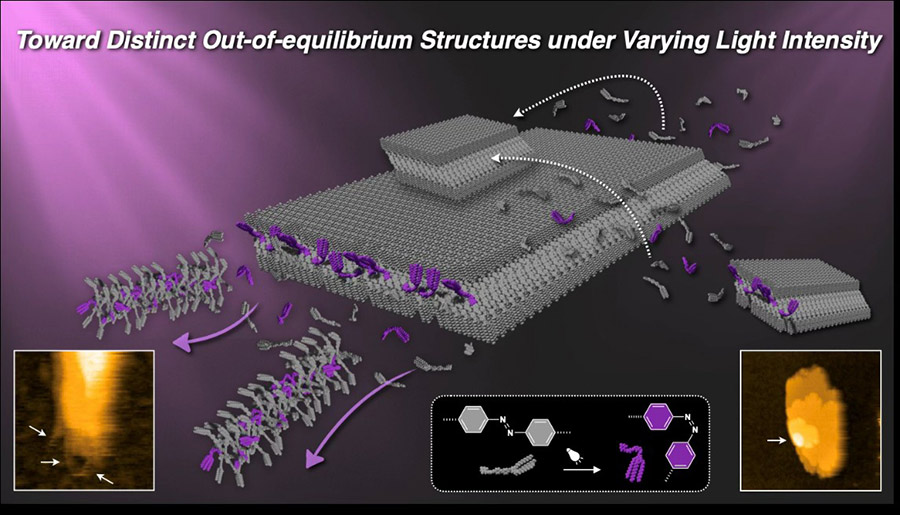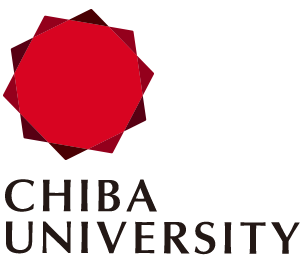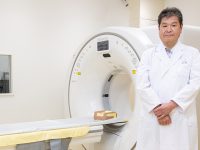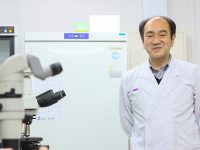Scientists have discovered a method to transform these molecular assemblies into dimensionally distinct out-of-equilibrium structures
Out-of-equilibrium states that deviate from thermodynamic equilibrium are crucial not only for biological systems but also for designing synthetic functional materials. Now, researchers from Japan have developed supramolecular 2D nanosheets capable of transforming into dimensionally distinct out-of-equilibrium structures depending on ultraviolet light intensity. This work opens a new avenue for designing advanced adaptive materials that exhibit diverse responses depending on the light energy applied.

Image title: How dimensionally distinct supramolecular structures arise under different light intensities
Image caption: Researchers identified how light intensity affects out-of-equilibrium dynamics, opening new avenues for developing adaptive materials.
Image credit: Assistant Professor Kenta Tamaki from Chiba University, Japan
Image license: Original Content
Usage Restrictions: Cannot be reused without permission.
Constructing out-of-equilibrium molecular assemblies that deviate from thermodynamic equilibrium is a central challenge in materials science. While numerous studies have reported the creation of such states using external energy sources such as chemical fuels or light, few systems can adaptively access different states depending on how much energy is input. Developing such systems could offer new design principles for advanced functional materials capable of flexibly adapting to environmental changes, much like biological systems.
In a recent study published online in Chem on November 17, 2025, researchers in Japan reported a supramolecular polymer system that can produce out-of-equilibrium states with distinct dimensionalities depending on the intensity of light applied. Using high-speed atomic force microscopy (HS-AFM), the research team revealed the underlying mechanisms of these dynamic transformations. The study was led by Professor Shiki Yagai from Chiba University, Dr. Christian Ganser from Exploratory Research Center on Life and Living Systems, National Institutes of Natural Sciences, and Professor Masaki Kawano from Institute of Science Tokyo, with Assistant Professor Kenta Tamaki from Nagoya University (affiliated with Chiba University at the time of the research) as the first author.
“Our group has long been pursuing unique research aimed at controlling the nano- to mesoscale morphologies of molecular assemblies using light,” says Prof. Yagai. “However, we had not yet realized an out-of-equilibrium system that, much like living organisms, changes its structure or state depending on the amount of energy it receives. In this project, we hypothesized that by incorporating a light-responsive unit into a molecule already known to exhibit different assembly structures under different conditions, we might be able to guide it into distinct assemblies simply by varying the light intensity—and that idea marked the beginning of this study,” says Prof. Yagai, speaking of the inspiration behind this study.
To design the new system, the team attempted to integrate photoinduced structural changes at the molecular level (photoisomerization) with supramolecular polymorphism—structural variations at the mesoscale. They opted for azobenzene as the photoswitching unit and a barbituric acid-based merocyanine as the core responsible for hydrogen-bond-directed supramolecular polymorphism. The newly synthesized molecule initially self-assembled into 1D coiled nanofibers, but when the solution was left under ambient light, it spontaneously transformed into thermodynamically stable 2D nanosheets through hydrogen bond rearrangement.
Under strong ultraviolet light irradiation, the 2D nanosheets transformed back into 1D linear nanofibers as a result of azobenzene photoisomerization, which induced a reorganization of the hydrogen-bonding patterns. HS-AFM observations revealed that this transformation selectively occurred along specific nanocrystalline facets. Through single-crystal-guided structural analysis, the team found that these facets expose the photoswitching units, making them particularly susceptible to photons.
In contrast, under weak ultraviolet light irradiation, transmission electron microscopy (TEM) and AFM observations revealed that most of the smaller nanosheets disassembled, while some larger nanosheets grew vertically into 3D nanocrystals. These findings suggest that the transformation proceeds via an Ostwald ripening mechanism, wherein small nanosheets dissolve and the released molecules redeposit onto larger ones, causing the latter to grow at the expense of the former. HS-AFM further captured localized transformation events, including secondary nucleation and epitaxial growth, occurring during the Ostwald ripening process.
“This out-of-equilibrium supramolecular system paves the way for developing highly functional materials that can alter their states in response to external stimuli, much like living systems,” concludes Prof. Yagai. “Looking ahead, by incorporating photoactive, electroactive, or even catalytic functions directly into the molecular design, it may be possible to create systems whose functional performance spontaneously adapts to environmental changes.”
To see more news from Chiba University, click here.
About Professor Shiki Yagai from Chiba University, Japan
Professor Shiki Yagai is a well-established researcher at Chiba University, Japan. In 2002, he received his Ph.D. from Ritsumeikan University, Japan. He joined Chiba University as an Assistant Professor and was promoted to Full Professor in 2017. He has authored over 200 publications, contributing to the fields of molecular self-assembly, supramolecular polymers, and functional dyes, with a focus on their nanostructural control. He leads the Grant-in-Aid for Transformative Research Areas (A) project titled “Materials Science of Meso-Hierarchy,” which spans from 2023 to 2027. This project focuses on exploring the hierarchical structures of materials to develop innovative functional materials at the mesoscopic scale. The initiative aims to deepen our understanding of meso-hierarchical structures and their impact on material properties, potentially leading to breakthroughs in material design and applications.
Funding:
This study was supported by the Japan Society for the Promotion of Science (JSPS) KAKENHI grant nos. JP22KJ0486, JP22H00331, JP23H04873, JP23H04874, and JP23H04878.
Reference:
Title of original paper: Light-intensity-dependent out-of-equilibrium processes toward dimensionally distinct nanopolymorphs
Authors: Kenta Tamaki1, Hiroki Hanayama2, Sougata Datta3, Fabien Silly4, Yuki Wada5, Daisuke Hashizume6, Kiyohiro Adachi6, Takayuki Uchihashi7,8, Masaki Kawano5, Christian Ganser8, and Shiki Yagai2,3
Affiliations:
1Graduate School of Science and Engineering, Chiba University, Japan
2Graduate School of Engineering, Chiba University, Japan
3Institute for Advanced Academic Research (IAAR), Chiba University, Japan
4Université Paris-Saclay, France
5School of Science, Institute of Science Tokyo, Japan
6RIKEN Center for Emergent Matter Science, Japan
7Department of Physics, Nagoya University, Japan
8Exploratory Research Center on Life and Living Systems, National Institutes of Natural Sciences, Japan
Journal: Chem
DOI: 10.1016/j.chempr.2025.102818
Contact: Shiki Yagai
Institute for Advanced Academic Research (IAAR)
Graduate School of Engineering, Chiba University, Japan
Email: yagai@faculty.chiba-u.jp
Academic Research & Innovation Management Organization (IMO), Chiba University
Address: 1-33 Yayoi, Inage, Chiba 263-8522 Japan
Email: cn-info@chiba-u.jp
Research Enhancement Strategy Office, Exploratory Research Center on Life and Living Systems (ExCELLS), National Institutes of Natural Sciences
Address: 5-1 Higashiyama Myodaiji, Okazaki, Aichi 444-8787 Japan
Email: press@excells.orion.ac.jp





